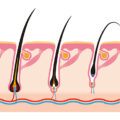Last updated on June 3, 2024

Can you lose transplanted hair?
Hair transplant is a popular hair restoration procedure that involves the transplantation of healthy hair follicles from one part of your scalp to another. While this technique has become increasingly sophisticated over time, many people still wonder if it’s possible to lose their transplanted hair after undergoing the procedure.
The good news is that most people who undergo a successful hair transplant experience long-lasting results. Once the grafts are firmly established in their new location, they will continue to grow like natural hair and won’t fall out easily.
However, there are some potential reasons why you might experience continued hair loss even after having a successful transplant. For instance, if you have an underlying medical condition that affects the ability of the hair follicle to grow healthy hairs or if you don’t follow proper postoperative care instructions, your transplanted hairs may not take root as well as they should.
In addition, some patients may simply continue to experience normal age-related thinning or balding in areas where they did not receive a transplant. It’s important to remember that while hair transplant surgery can produce dramatic results for many individuals, it isn’t always guaranteed to stop all forms of future hair loss. This is why a good Hair Restoration specialist will combine a Hair Transplant with other non-surgical multi-therapies.
Why is a hair transplant permanent?
Hair transplants (fue hair transplant or fut hair transplantation) are a popular solution for those suffering from male pattern hair loss. But have you ever wondered why it’s said to be a permanent fix? It all comes down to the science behind how the procedure works.
During a hair transplant, individual follicles are extracted from an area of the scalp with healthy hair growth and then transplanted into the balding or thinning areas. The key here is that these follicles are genetically resistant to baldness, so they will continue to grow even in their new location.
Once transplanted, these newly implanted hairs will go through a shedding phase before beginning to regrow within three to four months. From there on out, they’ll continue growing just like any other natural hair on your head. However it is also important to care for your transplanted hair as well as your original hair to maintain its longevity.
Protecting Your Transplanted Hair: Tips for Long-lasting Results
To maximise the longevity of your hair transplant, consider the following tips:
- Choose an experienced surgeon: A skilled surgeon will carefully select donor hair follicles that have a higher likelihood of surviving the transplant process and being resistant to DHT.
- Adhere to post-operative care instructions: Proper care of the transplant site is crucial for ensuring the best possible results. Follow your surgeon’s guidelines for post-operative care to promote healing and reduce the risk of complications.
- Maintain a healthy lifestyle: A balanced diet, regular exercise, and stress management can contribute to the overall health of your hair, including your transplanted hair.
- Consider additional treatments: In some cases, your surgeon may recommend supplemental treatments, such as PRP therapy or medications for hair shedding or temporary hair loss, to help maintain the health and longevity of your transplanted hair.
Benefits of hair transplants
Hair transplant surgery is a highly effective and permanent solution for those suffering from hair loss. While it is possible to lose some transplanted hairs in rare cases, this is not common and the vast majority of patients enjoy lasting results. More likely is temporary hair shedding in the early months after hair transplantation surgery or see forehead reduction before and after photos for comparison.
In addition to restoring one’s appearance and confidence, there are many tangible benefits to getting hair transplantation. For example, having a full head of hair can make you look younger and more attractive. It can also make it easier to style your hair or try new looks that were previously impossible with thinning or balding areas.
But perhaps most importantly, getting a hair transplant can improve your overall quality of life by reducing stress and increasing self-esteem. If you’ve been struggling with hair loss for years, undergoing this procedure could be just what you need to start feeling like yourself again.
What to do next?
Carrying out hair transplantation for male pattern hair loss, thinning hair or further hair loss is a delicate and complex procedure that requires the expertise of a skilled doctor. If you’re interested in learning more about whether a hair transplant is right for you, don’t hesitate to reach out to an experienced professional today!








